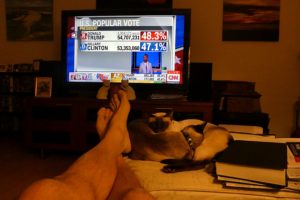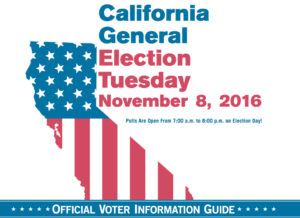The Propositions
There are five (5) propositions on the California ballot for June 5th, 2018 primary election. The California State Legislature put all of these measures on the ballot. Four (4) of them are “legislative constitutional amendments” and the fifth is a bond measure.
First, the bond measure.
Proposition #68: Authorizes bonds funding parks, natural resources protection, climate adaptation, water quality and supply, and flood protection.
These are good things; indeed, they are necessary things. But . . . they are not things which should be financed (IMHO) by borrowing the money and forcing our children and grandchildren to pay these costs. Currently, California is in debt to the tune of $400+ billion. Yes, that is equal to more than $10,000 per resident.
While all of this debt is not due to bonds, I do not believe that we should add to that debt by issuing another $4 billion in general obligation bonds to finance the above.
If you click on the above, US Debt Clock takes you the the site for the US National Debt while California takes you to the debt for the state of California. Both provide some “fascinating” numbers and food for thought.
Other propositions
Proposition #69: Requires that certain new transportation revenues be used for transportation purposes.
We have too many transportation needs to list here and, in general, I favor limiting the use of transportation related taxes and fees to our transportation needs. But . . . this proposition is limited to only a few of those revenue sources. We already have one of the world’s longest constitutions — 100+ pages — and I do not believe that this measure should become a part of it. I would, however, favor an amendment that included all transportation related taxes and fees (except, maybe, general sales taxes) and limiting the spending of those monies to transportation related measures.
Supermajority
Proposition #70: Requires legislative supermajority vote approving use of cap-and-trade reserve fund.
Supermajority — two-thirds vote of the legislature.
I have serious doubts about “supermajorities.” I believe that, in many cases, their sole purpose is to defeat democracy. That is, to enshrine in our constitution the current political climate and prevent future generations from exercising their rights.
Proposition #71: Sets effective dates for ballot measures.
If common sense ruled California, this would not be necessary. In fact, Wm. Shakespeare wrote a comedy about items such as this: Much Ado About Nothing.
For more information see pages 22-25 of the Official Voter Information Guide.
Proposition #72: Permits legislature to exclude newly constructed rain-capture systems from property-tax reassessment requirement.
If you put in a system to collect and store rainwater on your property, you won’t have to pay higher property taxes because the system increased your property’s value.
There is no argument in the Information Guide against this measure.
Other things:
Want to follow (some of) the money? — http://fppc.ca.gov/transparency/top-contributors.html
Pages 30 & 31 of the Information Guide provides an Overview of State Bond Debt and page 31 has a short explanation of the California “Top Two” primary system.
Candidate statements are available on pages 37-83. (“Each statement was voluntarily submitted and paid for by the candidate.”) Some are revealing, at least to me. Many include email and website information.
Monday, May 21st, 2018 is the last day to register to vote.
Remember: whether you are liberal or conservative, radical or reactionary, or consider yourself to be a rational moderate (as I consider myself to be), this election is your chance to make your voice heard —  Vote!
Vote!

 I am not a reading teacher nor a statistician, but I have used the Grammar Analysis tools available in various editions of MS Word to analyze the textbooks I have used as well as many of my assignments, tests and notes to both students and parents.
I am not a reading teacher nor a statistician, but I have used the Grammar Analysis tools available in various editions of MS Word to analyze the textbooks I have used as well as many of my assignments, tests and notes to both students and parents. The above “analysis” is not scientific; it is personal. I have taken what I believe to be representative sections of the Voter Information Guide and subjected them to an easy to use and verify reading level analysis. Other tools and sections may (and probably will) give different results.
The above “analysis” is not scientific; it is personal. I have taken what I believe to be representative sections of the Voter Information Guide and subjected them to an easy to use and verify reading level analysis. Other tools and sections may (and probably will) give different results.


 The Sample Ballot / Practice Ballot followed; three pages in length and fourth blank page — “This page left intentionally blank”
The Sample Ballot / Practice Ballot followed; three pages in length and fourth blank page — “This page left intentionally blank”